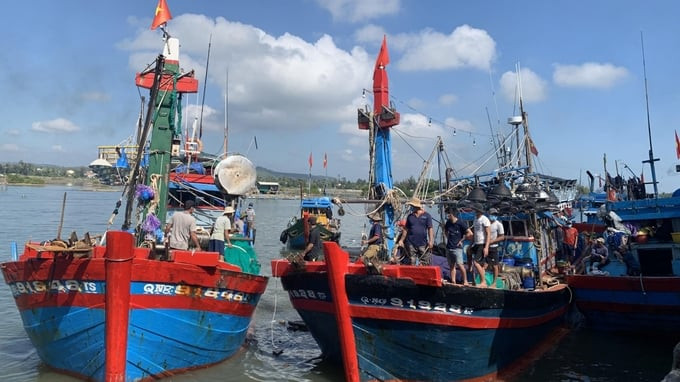According to statistics, Vietnam has over 1 million square kilometers of exclusive economic zone, and the dedicated mariculture area represents only over 20% of the total aquaculture area nationwide. Consequently, there is considerable potential for the development of mariculture. However, due to various subjective and objective reasons, the full potential and inherent advantages of mariculture in Vietnam have not been fully utilized.
According to a report from the Directorate of Fisheries under the Ministry of Agriculture and Rural Development, the total area of mariculture in the country reached over 256,000 hectares, with a total yield of nearly 750,000 tons, in 2022; the total yield is expected to reach nearly 800,000 tons in 2023.
The Government, the Prime Minister, and the Ministry of Agriculture and Rural Development have implemented multiple policies and programs over the years in order to promote the development of mariculture. Thanks to these concerted efforts, several supporting factors for the mariculture industry have begun to emerged in Vietnam, including broodstock production infrastructures, concentrated farming areas, supporting industries such as feed and breeding equipment, processing industries, and the development of consumer markets.

Vietnam's total mariculture area reached over 256,000 hectares in 2022
However, the development of the mariculture industry continues to encounter numerous difficulties, with industrial mariculture being the most challenging. Namely, there are issues involving planning and the implementation of mariculture plans are not effectively executed, and spontaneous farming activities that deviate from the planned structure are common occurrences. As a result, the development of mariculture in Vietnam is hindered by environmental pollution, difficult product consumption, and numerous other challenges. Additionally, limitations in seed production technology, health and environmental management in farming areas, and disease prevention on cultured species pose as obstacles to the overall development of this industry.
The supporting infrastructure for industrial mariculture, the development of supporting industries, such as cage farming systems, environmental monitoring and disease surveillance equipment, harvesting and transportation technologies, processing technologies, and market development, have not been systematically developed. Financial and human resources are also limited. Additionally, research and market forecasting for the consumption of maricultural products require improvements.
In response to the global context of declining seafood resources, the Ministry of Agriculture and Rural Development has set the development of sustainable and modern industrial mariculture is one of its central and urgent tasks.
Following the guidance of the Ministry of Agriculture and Rural Development, the Vietnam Agriculture Newspaper, in collaboration with the Directorate of Fisheries, the Department of Quality, Processing, and Market Development, the Department of Animal Health, and the Office of the Ministry of Agriculture and Rural Development, organized the conference "Current situation of supplying seeds, feed, and aquaculture equipment; traceability of product origin, and solutions for sustainable development of marine aquaculture in Vietnam" on November 25, 2023 in Nha Trang City, Khanh Hoa province.
The conference was chaired by Deputy Minister of Agriculture and Rural Development Phung Duc Tien and the leadership of the People's Committee of Khanh Hoa Province. In addition, there was participation from representatives of units under the Ministry of Agriculture and Rural Development, other ministries, localities, industry associations, international organizations, aquaculture businesses, and over 30 central and local press agencies.

Mariculture has significant potential for development. However, due to various subjective and objective reasons, the full potential and inherent advantages of mariculture in Vietnam have not been fully utilized
Vietnam's current development orientation for mariculture in the near future involves: moving towards industrialization with advanced technology, strict planning, modern management methods; promoting mariculture in coastal areas, offshore areas, far-offshore areas, and onshore; utilizing the biodiversity of tropical regions; integrating economic and technical resources from other industries such as oil and gas, shipbuilding, maritime transport, mechanical manufacturing, tourism, and automation in aquaculture and seafood processing; utilizing environmentally friendly technologies to prevent impacts on the ecosystem, and foster sustainable development; utilizing international cooperation as a key approach in attracting advanced technology, capital, and markets; fostering a professional and well-trained management and human resource.
The conference is organized with the aim of serving as a bridge for managers, experts, scientists, businesses, organizations, individuals, and relevant parties to collectively assess the state of mariculture in Vietnam, including aspects such as broodstock, feed, supplies, farming practices, technology, processing, consumption, product origin traceability, and international cooperation. Ultimately, participants of the conference will attempt to formulate solutions for the development of industrial mariculture, in addition to assisting businesses in identifying investment opportunities in industrial mariculture and seafood processing in the near future.
Additionally, the conference will focus on discussing solutions to overcome challenges in lobster farming, with a focus on the recently restricted export of Vietnamese spiny lobster to the Chinese market.
Translated by Nguyen Hai Long


















